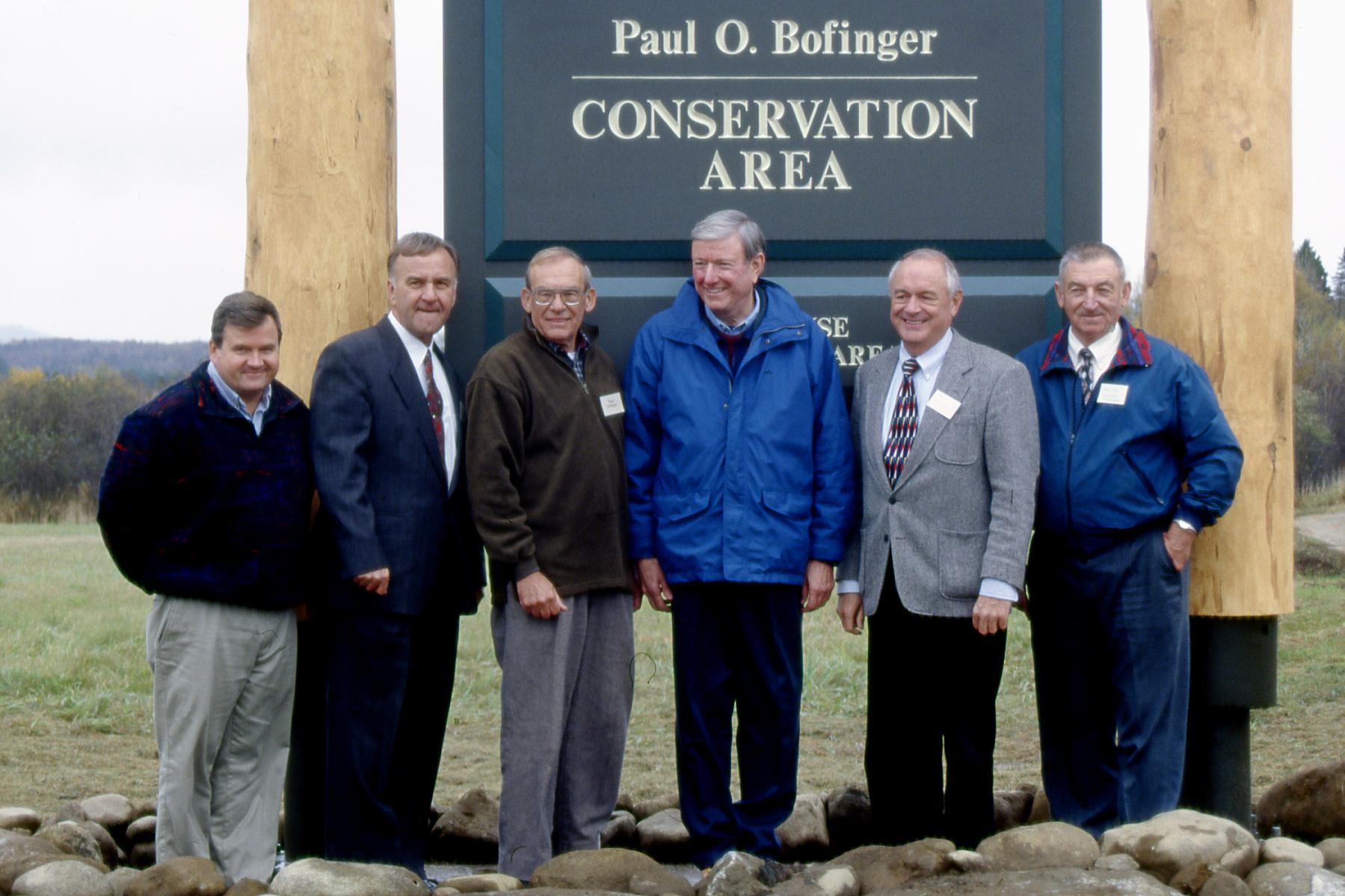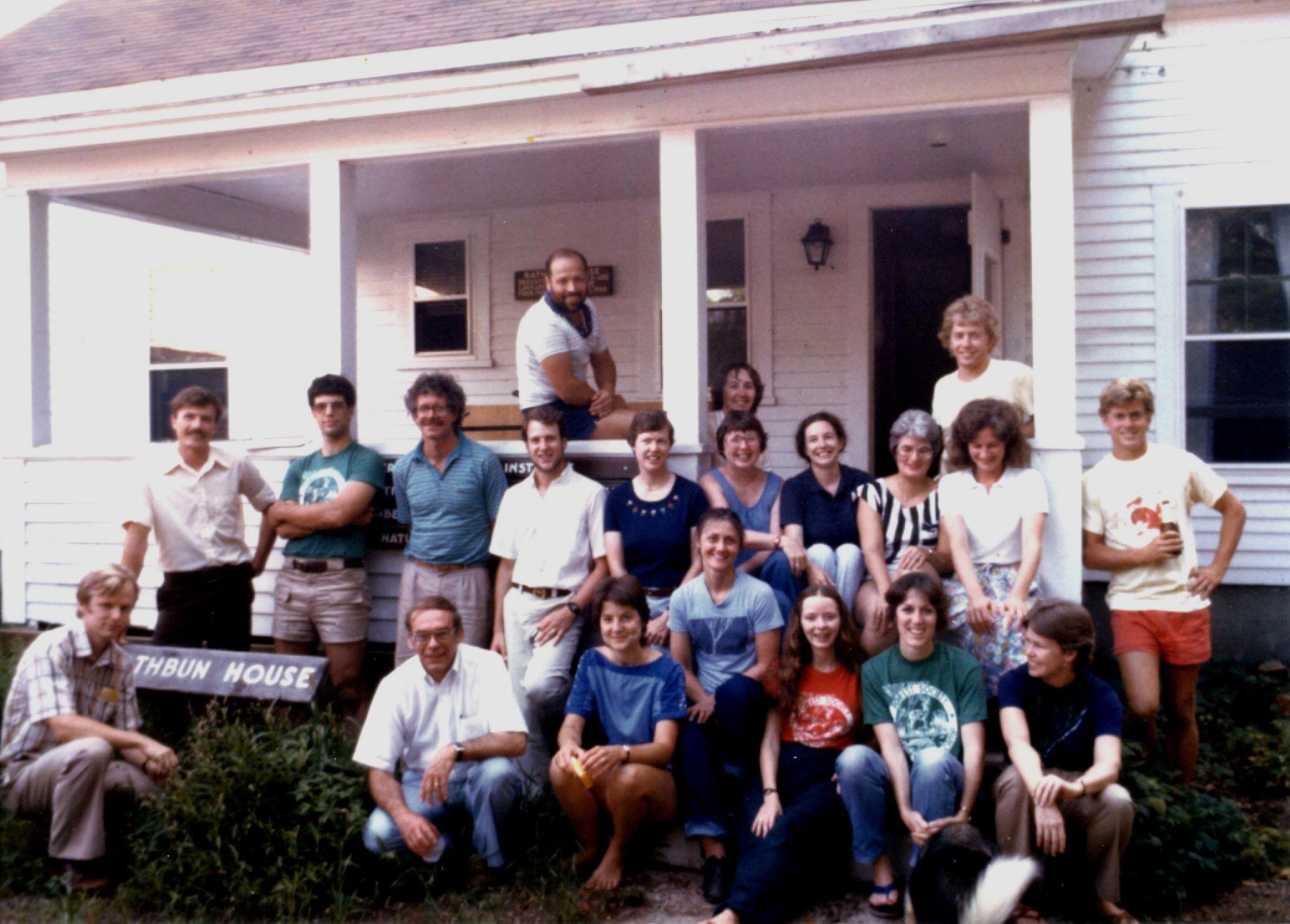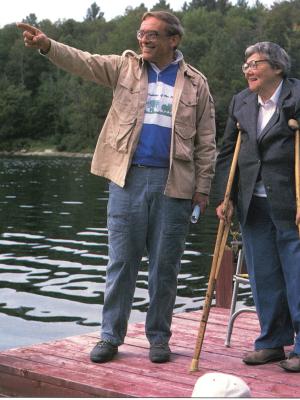Forest Society staff remember land conservation pioneer and President-forester

Paul O. Bofinger, President/Forester of the Society for the Protection of New Hampshire Forests 1965-1996
With the recent passing of 85-year-old Paul Bofinger, the State of New Hampshire lost a remarkable visionary, the Forest Society lost a former leader and many others lost a valued mentor who helped shape their careers as leaders in the professional fields of land conservation, natural science, education, policy, forestry and philanthropy.
Bofinger’s early leadership as conservation visionary resulted in creation of new tools and tactics which the land conservation community use daily without thinking about origins. For instance, Paul oversaw the advent and early use of deed restrictions and conservation easements in New Hampshire.
Will Abbott, VP for Land Management and Policy at the Forest Society says: "The impact of Paul’s conservation legacy is huge. It’s difficult to compress it, but in my view four things stand out: the campaign for Current Use, the second saving of Franconia Notch, the partnership between the Trust for NH Lands (TNHL) and the Land Conservation Investment Program (LCIP) and the work at The Northern Forest Lands Council."
“Yes on Seven” The statewide campaign for “Current Use” assessment and taxation.
Early in his career at the Forest Society, Paul helped lead the statewide effort to enact an amendment to the New Hampshire Constitution to enabled Current Use taxation - taxing land at its “productive capacity.” In other words, land is taxed as a woodlot, open space, or a farm, not as a potential site for houses. Because the taxes are consistent with the land use, it is easier for landowners to keep their open space undeveloped. The 1968 ballot referendum was approved by NH voters, creating the most significant land conservation initiative in the State’s history. Paul helped lead the charge. A week before the 1968 vote, it became clear the vote would be close. Paul leafletted cars all over Concord with a handbill asking voters to support the constitutional amendment. Concord voters adopted the amendment by a slim margin – leading Paul to conclude his leafletting was a worthwhile investment of time. Today, more than half of the state’s landscape is enrolled in Current Use. The character of New Hampshire would be very different had the vote gone the other way.
Franconia Notch: Interstate highway vs. scenic two-lane “Parkway”
Under Paul’s leadership, The Forest Society worked with The Appalachian Mountain Club, The Conservation Law Foundation and other conservation organizations and citizens groups to limit the size of Interstate 93 as it travels through Franconia Notch State Park. The Forest Society was the leader in establishing the Franconia Notch State Park in 1928, and operated The Flume until the State created the State Park Agency in 1948. Paul created the White Mountain Environment Committee and engaged numerous groups to join and to lead the advocacy efforts on behalf of the establishment of a Franconia Notch Parkway that conserved the experience and ecology of the Notch. It also reduced the threat to the stability of the Old Man of the Mountains from blasting that would have been necessary to build a four lane highway. Paul understood that New Hampshire would be a better place if it stood up to advocate for the permanent protection of Franconia Notch State Park.
After the opponents of the four lane road won a substantial victory in federal court, and a key amendment to the federal highway act, highway planners became convinced that a two-lane parkway could meet future public transportation needs, Paul and The Society remained vigilant through the design and construction process tha was expanded to include major improvements to the Park facilities. Thanks to Paul's vision and determination, and those who joined the fight, the scenic experience of Franconia Notch was preserved for future generations.

Trust For New Hampshire Lands / Land Conservation Investment Program
Paul took a well-earned sabbatical in the mid 1980’s, during which he spent time in Europe visiting with conservationists and foresters continent wide. He came back with the novel idea for New Hampshire to create a unique new public-private partnership to leverage a one-time, large public investment in the conservation of important lands and landscapes. The Forest Society created a separate non-profit organization called the “Trust for New Hampshire Lands” to work with the new six-year state agency called the “Land Conservation Investment Program.” TNHL would provide the planning and staffing capacity to seek out landowners to apply for competitive grants to be awarded by LCIP. LCIP would provide the state infrastructure to decide on what projects to fund and to then to execute the transactions with TNHL staff. The LCIP also provided for state stewardship of these new assets. In all, over 360 transactions were completed including new acquisitions of land for the public use and new acquisitions of conservation easements to be publicly held to protect exceptional conservation values of statewide significance. A feature of this unique partnership is that grants were made to municipalities for the permanent conservation of lands that NH towns themselves deemed important locally. These investments would never have happened without Paul’s political leadership and perseverance.
The Northern Forest Lands
By the 1980s it became clear that a major transition was underway with large blocks of forest land owned and managed by vertically-integrated paper companies. Paper companies began to sell large blocks of land and began to close older, less profitable paper mills. Paul was concerned about the future of these large blocks of forestland, and helped persuade the US Forest Service to study options for the future protection of these lands as working forests under some form of private ownership. The forest service asked the governors of New York, Vermont, New Hampshire and Maine to each appoint three people to serve as a working study committee. Paul was one of the New Hampshire representative. This study committee led to the creation of the Northern Forest Lands Council, which identified strategies and public policies that would conserve the northern forests in four states. Ultimately, the states succeeded in finding new ways to keep these lands largely intact, such as the New Hampshire effort to place a conservation easement on 161,400 acres of the Connecticut Lakes Headwaters, a privately owned working forest in three northern New Hampshire towns. One lasting contribution of the work of the Northern Forest Lands Council was the creation of the Northern Forest Center, which works to promote and develop the working forest economies of the region. The NFC is based in Concord, NH. Paul Bofinger was a founding board member.
Nash Stream: A First of Its Kind Conservation Victory
The Northern Forest Lands Study and Commission came about in large part because of a land sale that raised eyebrows in the wider forestry community. Diamond International Company, which had major land holdings in the North Country and a mill in Groveton, was purchased by an investment speculator and then the lands were put on the market. A developer from Nashua bought most of the NH property with plans to develop and mine gravel from a portion of the holdings known as the 40,000 acre Nash Stream tract.
While the Northern Forest Lands study looked at the regional implications of the land sale, Paul also focused like a laser on the protection of the Nash Stream tract. He partnered with the Nature Conservancy and then Governor John H. Sununu to negotiate a deal with the developer in which the State would buy the land and the US Forest Service would buy a conservation easement.
Thanks to Paul’s persuasive skills, the Governor and LCIP agreed to fund the state purchase, and US Senator Judd Gregg was successful in helping obtain the authorization the Forest Service needed to buy the easement. Nash Stream (state) Forest was established and the traditional forestry and recreation uses of the land were secured. This model, a first, quickly gained national attention and is now credited with being the precedent that led to the establishment of the national Forest Legacy Program that has subsequently protected 2.6 million acres of privatey owned working forest land across the country.
Projects, Places and a legacy of People
Jane Difley succeeeded Bofinger as Forest Society President-forester before retiring in September, 2019. “Paul was the conscience of conservation in New Hampshire, instrumental in protecting its waters, fisheries and wildlife as well as its forests,” Difley said. “He was the consummate negotiator successfully working with others to create legislation enabling conservation commissions, wetlands protections and current use. He understood and worked tirelessly to make sure that the White Mountain National Forest was a model of both wilderness protection and sustainable forestry.”

Beyond the extraordinary legacy of projects, places and politics is the landscape of New Hampshire people whose subsequent careers Paul Bofinger influenced. Jane Difley relates how Bofinger’s advocacy inspired a generation of people like herself to enter conservation and forestry.
“Paul was a mentor for countless conservationists, myself included, who went on to influence the protection of New Hampshire’s environment. New Hampshire is the beautiful state we know today because of Paul’s work”
- Jane A. Difley
Paul A Doscher, former VP for Land Conservation Programs at the Forest Society adds "Paul led with passion and wisdom. He had a determination that for any solution to work, every stakeholder in the problem needed to be at the table. He and former US Senator Judd Gregg called it “The New Hampshire Way.” Get the representatives of all the different perspectives on a given problem together and make sure all their voices are heard. No one knew better than Paul that any lasting solution to a conflict required compromise and collaboration."

Doscher says that "One of Paul's greatest skills was choosing the best people for the jobs at the Forest Society. He would somehow manage to know instinctively who was the best candidate, get them trained - put them to work, and give them goals and then say ‘other than that, you’re on your own.' That vote of confidence inspired fierce loyalty to both Paul and to the mission."
Sarah Thorne worked as the Director of Land Protection for both the Forest Society and the Trust for NH Lands. She remembers "The TNHL was founded on the trust and respect people placed in Paul. Over 100,000 acres of the iconic landscapes of the state never would have been conserved without Paul's leadership and drive— Lake Umbagog, Shaker Village, expanding Odiorne Point, Connecticut River farms, Nash Stream, and so many new town forests, boat landings, waterfowl marshes, and community trails and historic farms. The public-private partnership between the Trust for NH Lands and the state’s Land Conservation Investment Program became the model for the Land and Community Heritage Investment Program, which has been tremendously successful since then. Paul's long shadow continues to inspire us all even years after his 1996 retirement."
Thorne continued her work on the Forest Society land conservation staff, eventually heading the Conservation Institute at The Forest Society and then teaching high school environmental science and working with the Hubbard Brook Research Foundation at the Hubbard Brook Experimental Forest in North Woodstock, NH. Sarah reflects: “The older I get, the more amazed I am that Paul gave me so many early opportunities. Paul was quite liberated in the sense of how he treated the female Forest Society staff. I owe him everything in terms of my chosen career path in both forest conservation and environmental education.”
Will Abbott remembers how Paul Bofinger often affectionately referred to the Forest Society as “The Mother Society” in conversation - as a reminder that what’s best for New Hampshire as a whole is usually the best course of action for The Forest Society to pursue.
Dave Anderson, Senior Director of Education at the Forest Society recalls Bofinger's more colorful phrasing. "Paul had a knack for colloquialism, possibly inventing new ones. He would not hesitate to fire off missives - recorded on bright yellow memos titled: 'From the Desk of Paul Bofinger.' While trained and licensed as a NH forester, Paul’s legacy seems less about managing trees and more about successfully building coalitions of individuals and groups to accomplish broad land conservation and policy initiatives. Paul was effective in politics and conservation finance. His persuasion skills remain legendary. Paul was a pioneer, an architect and mastermind for the boldest NH land conservation milestones of the past century."
“It was an honor to know Paul, and I appreciated hearing his perspective early on when I was editor of Forest Notes,” said Jack Savage, current president of the Forest Society. “Paul’s legacy of accomplishment in the 20th century sets a high standard for the Forest Society going forward through the 21st century.”
Read the Union Leader's story on Paul Bofinger's legacy.
Read Paul Bofinger's obituary and sign a virtual guest book.
Read a special issue of Forest Notes from 1996 honoring Paul.
